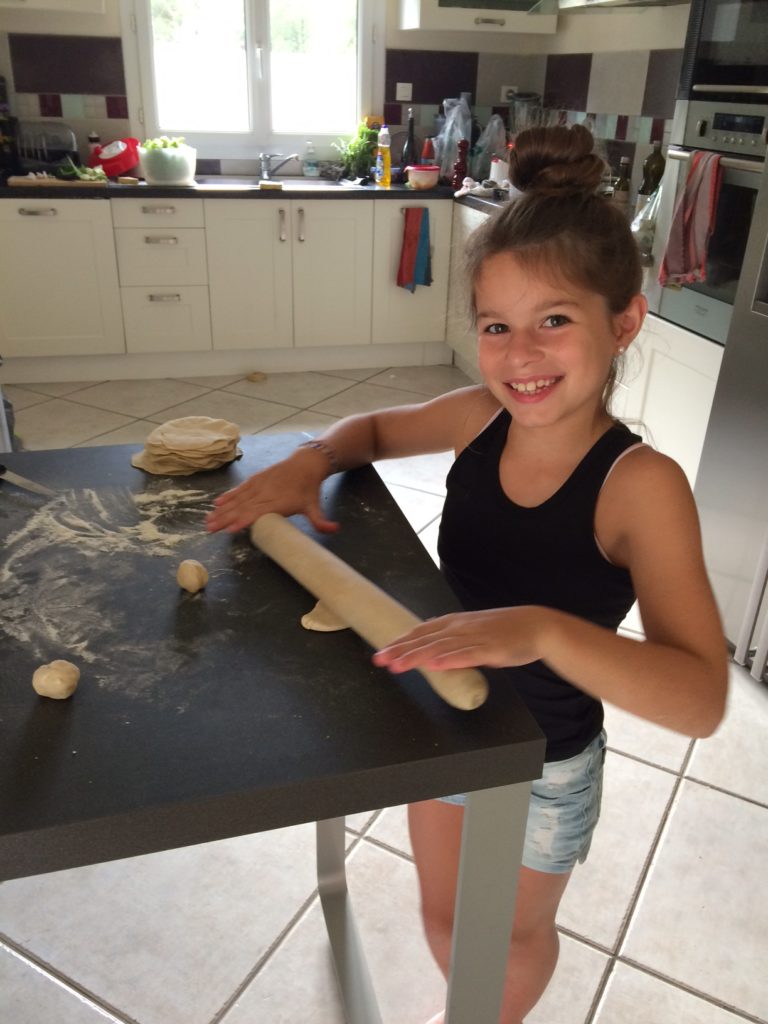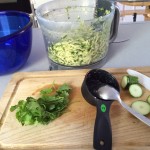I can only call these this Magic Dumplings (MaDu for short – who ‘members TomKat?!) , because I have NEVER in my life seen The Main Man put anything resembling cooked cabbage ANYWHERE NEAR his gastrointestinal tract. And holy bejezus he asked for more. And the kids ate them?! So I can only deduce that the combination of the ingredients somehow turns into magic powder and makes them all agree to eat cooked veggies and quinoa. For reals people.
This is super easy, but does take a bit of time (mostly the rolling of the wrappers). Helpers can be enlisted (see photos).
This makes a nice finger food as an apéritif. Or combined with salad, a dinner.
Not gonna lie, the wrappers were a daunting enterprise; but totally easy and worth the extra time.
Magic Dumplings (MaDus)
Dumplings
2 cups flour (for gluten free people just use gluten free flour!)
3/4 cup just boiled water.
That’s it!!!
Measure the flour into a medium to large bowl and make a hole in the center. Boil the water, and when it reaches a rolling boil, remove from heat and let rest about 2 min. Add the just boiled water to the hole and mix the flour with the water – I find a wooden spoon works best. When the water is absorbed into the flour go at it with your hands (careful, the water is still a bit hot) until you get a “ball” that seems mostly uniform.
On a lightly floured surface work the dough for about 2-4 min, I use the heal of my hand until the end when I use my whole hand and fingers. When the dough seems fully combined and easy to handle place in a plastic bag for about an hour (or longer – the time is not such a big deal).
Filling
1 white or yellow onion
1 large stock celery
1 carrot (optional)
1 cup-ish or so of packed cabbage leaves
2-3 garlic cloves (depending on how garlic-y you’re feeling)
1/2 cup cooked quinoa
1/2 cup frozen peas
1 tablespoon tamari
1 drizzle toasted sesame oil
While your dumplings are plastic-bagging, start the quinoa.
Put the onion, celery, carrot, and cabbage in the food processor to chop everything into small pieces. Heat a heavy sauté pan on medium heat and add the onion/celery/carrot/cabbage mixture. When the veggies start to cook (about 3 min) mince the garlic and add to cooking veggies. Let everything cook together for about 10 minutes, being careful not to burn. The quinoa should now be finished, so add that to your veggie garlic mix, and add the frozen peas too. Cook everything for another 5 min or so, and add the tamari and the drizzle of toasted sesame oil. Careful, the sesame oil is strong, do little bits at a time and taste until you feel like you’ve reached optimal taste. Then set the filling aside.
Back to the wrappers:
When you are ready to roll the wrappers, using a lightly floured surface, break the dough into 20 or so pieces and roll into flat circles with a rolling pin. If you’re using regular flour, they are quite stretchy and after rolling, you can continue stretching with your hands to make the wrappers thinner. I stack them, adding bit of flour between each wrapper. DON’T don’t try stacking if it’s too hot – they tend to stick together – ask me how I know!
Now it’s time to fill. Place filling (about a tablespoon I think) in the center of the wrapper and fold the wrapper in half. Use your fingers to “seal” the two halves together and pinch all around the edge to keep the filling from coming out. Put all the ready to cook dumplings on a plate until you’ve done them all.
Now cook! With a thin sheet of oil (I used olive) in a heavy sauté pan (I use the same pan I used for the filling, but I wipe it out with a paper towel first) over medium heat, make one layer of dumplings. Allow the dumplings to cook on one side for about 3-5 min (you’re looking for a golden brown color). When one side is cooked, add a 1/4 cup water to the hot sauté pan and cover with a lid (careful – lots of steam). Let the dumplings steam for about 3-5 min and remove cooked dumplings to a bowl that you can cover with a towel to keep warm while you do the next batch. Before beginning next batch empty sauté pan so there is no leftover water. Re-oil with a thin sheet and repeat until you’ve cooked all the dumplings.
Serve while warm! They are a bit sticky, so don’t hesitate to serve with tamari/soy sauce or a mixture of tamari, lime and a bit of sesame oil.
It’s magic. Or maybe it’s salt.







